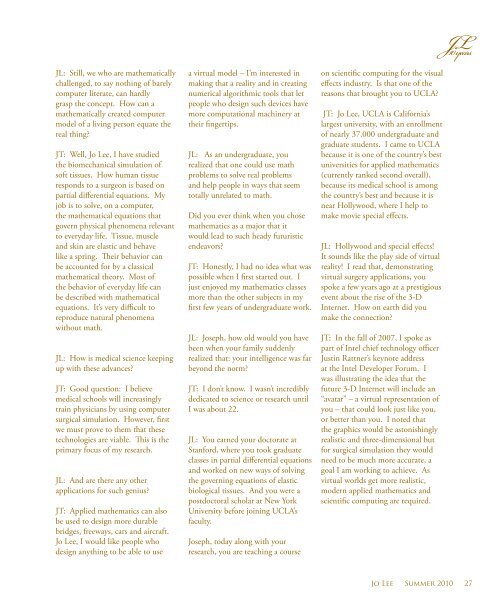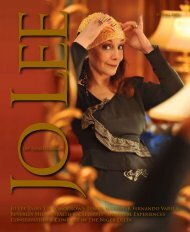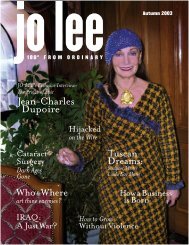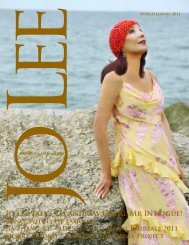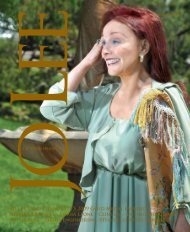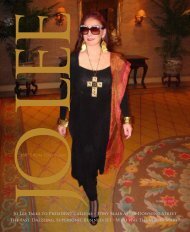Summer 2010 Jo Lee - JO LEE Magazine
Summer 2010 Jo Lee - JO LEE Magazine
Summer 2010 Jo Lee - JO LEE Magazine
Create successful ePaper yourself
Turn your PDF publications into a flip-book with our unique Google optimized e-Paper software.
JL 10 years<br />
JL: Still, we who are mathematically<br />
challenged, to say nothing of barely<br />
computer literate, can hardly<br />
grasp the concept. How can a<br />
mathematically created computer<br />
model of a living person equate the<br />
real thing?<br />
JT: Well, <strong>Jo</strong> <strong>Lee</strong>, I have studied<br />
the biomechanical simulation of<br />
soft tissues. How human tissue<br />
responds to a surgeon is based on<br />
partial differential equations. My<br />
job is to solve, on a computer,<br />
the mathematical equations that<br />
govern physical phenomena relevant<br />
to everyday life. Tissue, muscle<br />
and skin are elastic and behave<br />
like a spring. Their behavior can<br />
be accounted for by a classical<br />
mathematical theory. Most of<br />
the behavior of everyday life can<br />
be described with mathematical<br />
equations. It’s very difficult to<br />
reproduce natural phenomena<br />
without math.<br />
JL: How is medical science keeping<br />
up with these advances?<br />
JT: Good question: I believe<br />
medical schools will increasingly<br />
train physicians by using computer<br />
surgical simulation. However, first<br />
we must prove to them that these<br />
technologies are viable. This is the<br />
primary focus of my research.<br />
JL: And are there any other<br />
applications for such genius?<br />
JT: Applied mathematics can also<br />
be used to design more durable<br />
bridges, freeways, cars and aircraft.<br />
<strong>Jo</strong> <strong>Lee</strong>, I would like people who<br />
design anything to be able to use<br />
a virtual model – I’m interested in<br />
making that a reality and in creating<br />
numerical algorithmic tools that let<br />
people who design such devices have<br />
more computational machinery at<br />
their fingertips.<br />
JL: As an undergraduate, you<br />
realized that one could use math<br />
problems to solve real problems<br />
and help people in ways that seem<br />
totally unrelated to math.<br />
Did you ever think when you chose<br />
mathematics as a major that it<br />
would lead to such heady futuristic<br />
endeavors?<br />
JT: Honestly, I had no idea what was<br />
possible when I first started out. I<br />
just enjoyed my mathematics classes<br />
more than the other subjects in my<br />
first few years of undergraduate work.<br />
JL: <strong>Jo</strong>seph, how old would you have<br />
been when your family suddenly<br />
realized that: your intelligence was far<br />
beyond the norm?<br />
JT: I don’t know. I wasn’t incredibly<br />
dedicated to science or research until<br />
I was about 22.<br />
JL: You earned your doctorate at<br />
Stanford, where you took graduate<br />
classes in partial differential equations<br />
and worked on new ways of solving<br />
the governing equations of elastic<br />
biological tissues. And you were a<br />
postdoctoral scholar at New York<br />
University before joining UCLA’s<br />
faculty.<br />
<strong>Jo</strong>seph, today along with your<br />
research, you are teaching a course<br />
on scientific computing for the visual<br />
effects industry. Is that one of the<br />
reasons that brought you to UCLA?<br />
JT: <strong>Jo</strong> <strong>Lee</strong>, UCLA is California’s<br />
largest university, with an enrollment<br />
of nearly 37,000 undergraduate and<br />
graduate students. I came to UCLA<br />
because it is one of the country’s best<br />
universities for applied mathematics<br />
(currently ranked second overall),<br />
because its medical school is among<br />
the country’s best and because it is<br />
near Hollywood, where I help to<br />
make movie special effects.<br />
JL: Hollywood and special effects!<br />
It sounds like the play side of virtual<br />
reality! I read that, demonstrating<br />
virtual surgery applications, you<br />
spoke a few years ago at a prestigious<br />
event about the rise of the 3-D<br />
Internet. How on earth did you<br />
make the connection?<br />
JT: In the fall of 2007, I spoke as<br />
part of Intel chief technology officer<br />
Justin Rattner’s keynote address<br />
at the Intel Developer Forum. I<br />
was illustrating the idea that the<br />
future 3-D Internet will include an<br />
“avatar” – a virtual representation of<br />
you – that could look just like you,<br />
or better than you. I noted that<br />
the graphics would be astonishingly<br />
realistic and three-dimensional but<br />
for surgical simulation they would<br />
need to be much more accurate, a<br />
goal I am working to achieve. As<br />
virtual worlds get more realistic,<br />
modern applied mathematics and<br />
scientific computing are required.<br />
<strong>Jo</strong> <strong>Lee</strong> <strong>Summer</strong> <strong>2010</strong> 27


